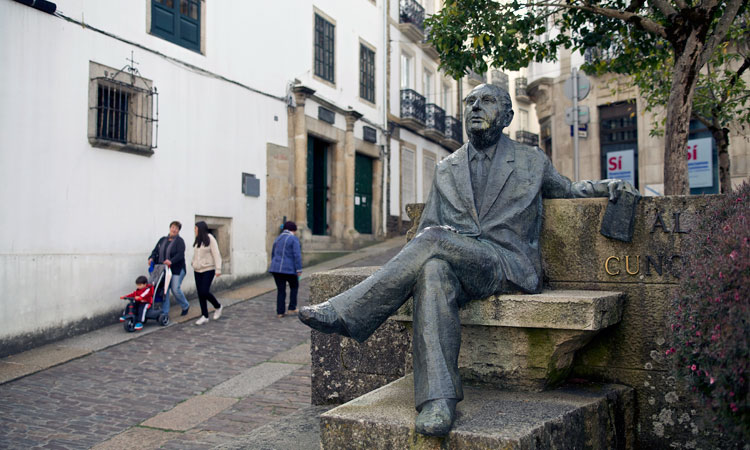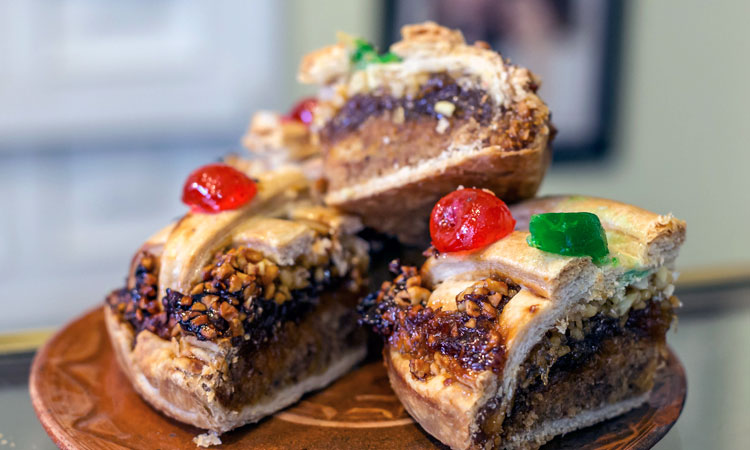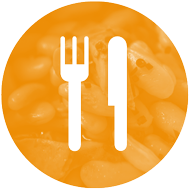Taste a menu (starter, 2 courses and dessert) inspired by the work of Álvaro Cunqueiro (20th century) Dishes that the great writer from Mondoñedo tasted a thousand times and recommended with passion.
Recommended season: winter
Time: 2 days
We take you through:
- Trabada
- Lourenzá
- Alfoz
- Mondoñedo
Did you know that?
Cunqueiro’s work is prolific (1911- 1981), in Galician and in Spanish. Several of his books are directly related to gastronomy such as A cociña galega, Viajes y yantares por Galicia: obra periodística en vida gallega, 1954-1963, La cocina cristiana de Occidente; with fairs like Os outros feirantes or with Galician culture like Ollar Galicia (1981, posthumous). Although the references to food in his texts are constant and frequent as with Merlín e familia.
Stops
The mythical Terras de Miranda, where writer Álvaro Cunqueiro places the narration of the book Merlín e familia (1955), is a space between fiction and reality. Cunqueiro was a travelling and a gourmet man and, in fact, Galician culinary art was a passion to which he devoted many pages of his work. We include some fragments in the stops of this route.
We will stop in Trabada to eat its famous and representative ‘enfariñada’, which some of the bars serve as a tapa. It is made with wheat flour, milk, eggs and salt, and then the dough is set in a frying pan and it is chopped up into pieces.
“And Mrs Marcelina put before him, on the plank of the seat, a ‘enfaragullada’ of wheat flour with pork scratchings.”
(Merlín e familia, 1955)
If you come in August, don’t miss out on the Threshing Festival Festival of Vilapena where the wheat is harvested the old-fashioned way in a day mixed with fun, work and tradition.
Soaking up nature is another way of getting to know this green municipality. Visit the Fraga da Belosiña and rest in its recreational area next to the river Trabada and the North Way.
As a first course, a Galician broth with beans will be served to you in Vilanova de Lourenzá.
“The broth, with green cabbage, turnip tops, cabbage, can be made in many ways. You can make a poor broth, with only ‘unto’ (lard) for the fat: the beans are put in water, and when they are almost done, add the potatoes cut to size, and finally the vegetables, when the potatoes are cooked. The ‘unto’ in the broth should be bought to a boil with the beans. But the broth can be improved, when the beans are put on to boil, you can add any pork meat, and when it starts to boil, at the end, the vegetables, or a chorizo that explodes in the broth.”
(A cociña galega, 1983)
The producers of the local cooperative organise visits during which they explain what their daily work consists of and the requirements for harvesting this legume with Protected Geographical Indication (GI). There is more information on its historical cultivation in the Bean Interpretation Centre or contact the organisers of the Bean Route to complete the experience.
If you enjoy moving around on your own, opt for the panoramic viewpoint of A Valiña.
We stop in the establishments of Alfoz to enjoy one of the stars of Galician gastronomy: ‘cocido’ (stew). A second course for any time of year, but better when it is cold.
“A good ‘cocido’ has many things: ham and pork shoulder, fresh meat, bacon and chorizo, chicken and chickpeas, and of course, potatoes. And the to pork that goes into the ‘cocido’ you can add salted ear and snout, and rib, if there is one. And with the water where everything was cooked you can make an excellent soup, rice or pasta.”
(A cociña galega, 1983)
In this stop we also offer you to visit a workshop where they prepare ‘cocido’ empanada (typical Galician pie).
To let the food go down, nothing better than a walk up to Castrodouro castle, known as well as the Tower of Homage, which is the municipal emblem. Or choose one of the three hiking trails of Alfoz: Pena Abaladoira, river Ouro or that of Castelos. They are of low or medium difficulty and with routes of between 10 and 18.8 km.
And for dessert, Mondoñedo cake! You can visit a patisserie where they make this sweet or buy it as a short-lived souvenir for you or your loved ones. In the words of Álvaro Cunqueiro:
“The most spectacular of all Galician cakes is that known as Mondoñedo cake, where a slightly flaky pastry base is put into a cake tin, then an angel hair layer is added, another of rum soaked sponge, and then another of quite coarsely ground almonds, and which is all very syrupy. And when it comes out of the oven, it is decorated with candied fruits and dried figs in syrup. There are three different flavoured layers, which complement each other, the whole thing is a Baroque sweet, although it is suspected that due to the shape and decoration it may have come from the Romanesque period. Recommend this splendid medieval sweet to the traveller, pride of the canonical kitchen of the old see.”
(Mirar Galicia, 1981)
In Mondoñedo, the birthplace of the writer, every corner reminds us of the author or any of his works. The historic area is declared a historic-artistic site and mandatory stops are, among others, the episcopal palace, the old town hall, the Fonte Vella (a fountain), the convent and church of the Conception, the convent of Alcántara, Os Muíños neighbourhood with the O Pasatempo bridge, the Álvaro Cunqueiro museum house and, of course, the statue of the writer who is always looking towards the cathedral and its square.














